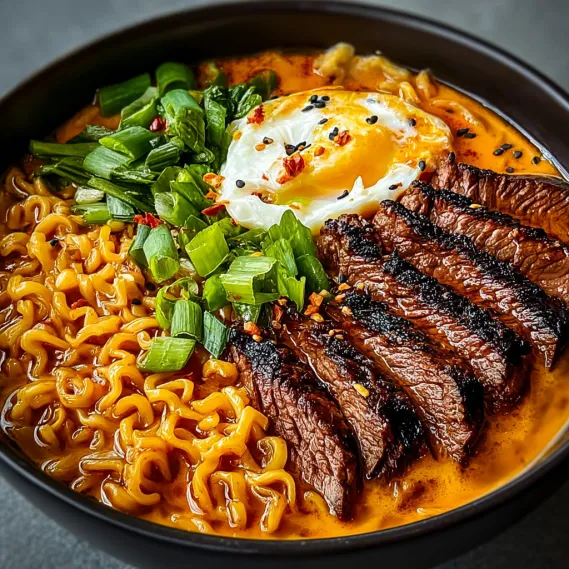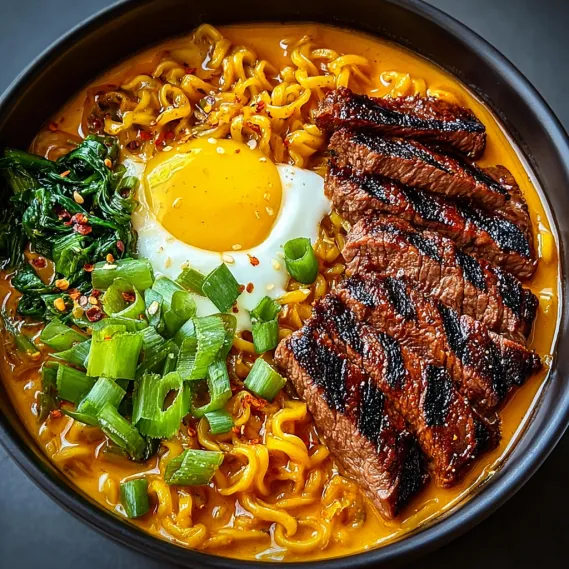 Pin
Pin
This hearty Spicy Korean Ramen with Grilled Beef & Creamy Sauce transforms simple instant noodles into a restaurant-worthy meal bursting with umami and heat. The marriage of tender grilled beef, spicy gochujang-infused noodles, and silky sauce creates layers of flavor that will transport your taste buds straight to Seoul.
I first created this recipe during a craving for something that reminded me of my favorite Korean restaurant that closed during the pandemic. After a few attempts at balancing the marinade and sauce, my family now requests this weekly as our Friday night special dinner.
Ingredients
- Flank steak or sirloin: Thinly sliced for quick cooking and maximum tenderness
- Gochujang: The star ingredient that provides authentic Korean spice and depth
- Korean instant ramen packages: Which offer superior texture to standard instant varieties
- Mayonnaise: Creates the creamy element that balances the heat
- Sesame oil: Imparts that distinctive nutty flavor essential to Korean cooking
- Fresh garlic and ginger: Provide aromatic foundation for the marinade
- Soy sauce: Adds umami depth and necessary saltiness
- Brown sugar: Balances the heat and helps create caramelization on the beef
Step-by-Step Instructions
- Marinate the Beef:
- Combine soy sauce, sesame oil, brown sugar, gochujang, minced garlic, grated ginger, rice vinegar, and black pepper in a bowl until smooth. Add your thinly sliced beef, ensuring each piece gets coated evenly. Let this sit for at least 30 minutes, though I find 2 hours creates even deeper flavor if you have the time.
- Prepare the Creamy Sauce:
- Mix mayonnaise, gochujang, soy sauce, honey, and warm water in a small bowl until completely smooth. The warm water helps thin it to the perfect drizzling consistency. This sauce should be silky and pourable, not thick like a dip. Set aside at room temperature so the flavors can meld while you prepare the other components.
- Cook the Noodles:
- Bring a pot of water to a rolling boil before adding your ramen noodles. Cook them just until al dente, about 2 minutes less than package instructions. Before draining, reserve a quarter cup of the starchy cooking water. Immediately rinse noodles under cold water to stop the cooking process and preserve their chewy texture.
- Create the Noodle Sauce:
- In a pan over low heat, combine gochujang, soy sauce, sesame oil, chili flakes, sugar, and the reserved noodle water. Stir until completely incorporated and slightly thickened. Add your drained noodles and toss continuously until every strand is glistening with the vibrant red sauce. Remove from heat immediately to prevent overcooking.
- Grill the Beef:
- Heat a grill pan until it begins to smoke slightly. Arrange marinated beef slices without overcrowding the pan. Sear for 2 to 3 minutes per side until you achieve nice charring while maintaining tenderness inside. The sugars in the marinade will create a beautiful caramelization. Work in batches to ensure proper searing.
- Assemble the Dish:
- Mound your sauced noodles in deep bowls, creating a nest in the center. Arrange the grilled beef attractively over the noodles. Drizzle generously with the creamy sauce, allowing it to cascade down into the noodles. Finish with a scattering of chopped scallions and toasted sesame seeds for color, texture and flavor.

The gochujang paste is truly the heart of this dish. I remember being hesitant about its intensity when I first cooked with it, but now I keep multiple varieties in my refrigerator. The complex fermented flavor it brings cannot be replicated with other hot sauces, and watching my formerly spice averse husband now liberally add extra to his bowl is a small cooking victory I cherish.
Perfect Beef Selection
The success of this dish relies heavily on properly cut beef. Look for well marbled cuts like ribeye or sirloin with visible fat streaks. For easiest slicing, place the beef in the freezer for 20 minutes first so it firms up without freezing solid. Then slice against the grain as thinly as possible, no thicker than ⅛ inch. This technique ensures maximum tenderness even with brief cooking time.
Gochujang Guide
Gochujang comes in various heat levels typically marked by numbers on the container. For beginners, start with level 1 or 2, which provides flavor without overwhelming heat. Level 3 offers a pleasant medium kick that most spice enthusiasts enjoy. Levels 4 and 5 bring serious heat that builds as you eat. The paste keeps for months refrigerated, so investing in a quality brand like Chung Jung One or Mother in Law's will elevate numerous Korean dishes in your repertoire.
Make It Your Own
This recipe welcomes personalization based on your preferences. Add a soft boiled egg with a jammy center for extra richness. Kimchi provides tangy crunch and probiotic benefits. For a vegetable boost, quickly stir fry thinly sliced mushrooms, spinach or bok choy and add them to your bowl. Vegetarians can substitute the beef with extra firm tofu marinated in the same mixture, then pan fried until crispy on the outside.
Common Questions About This Recipe
- → How do I marinate the beef for the best flavor?
Thinly slice the beef and let it soak in a mixture of soy sauce, sesame oil, brown sugar, gochujang, garlic, ginger, vinegar, and pepper for at least 30 minutes. This ensures each bite is flavorful and tender.
- → Why rinse the noodles after boiling?
Rinsing cooked noodles under cold water stops the cooking process, removes excess starch, and helps keep the noodles pleasantly chewy and prevents mushiness.
- → Can I use a different cut of beef?
Yes, flank steak or sirloin work well, but you can also use ribeye or even chicken for a different twist. Just slice thinly for quick, even cooking.
- → What adds creaminess to the sauce?
The sauce combines mayonnaise, gochujang, soy sauce, honey, and warm water, resulting in a rich, velvety texture and a balance of sweet heat and umami.
- → Which toppings boost the finishing touch?
Chopped scallions, toasted sesame seeds, shredded nori, pickled radish, and soft-boiled egg each add extra flavor, color, and contrasting textures to the bowl.
